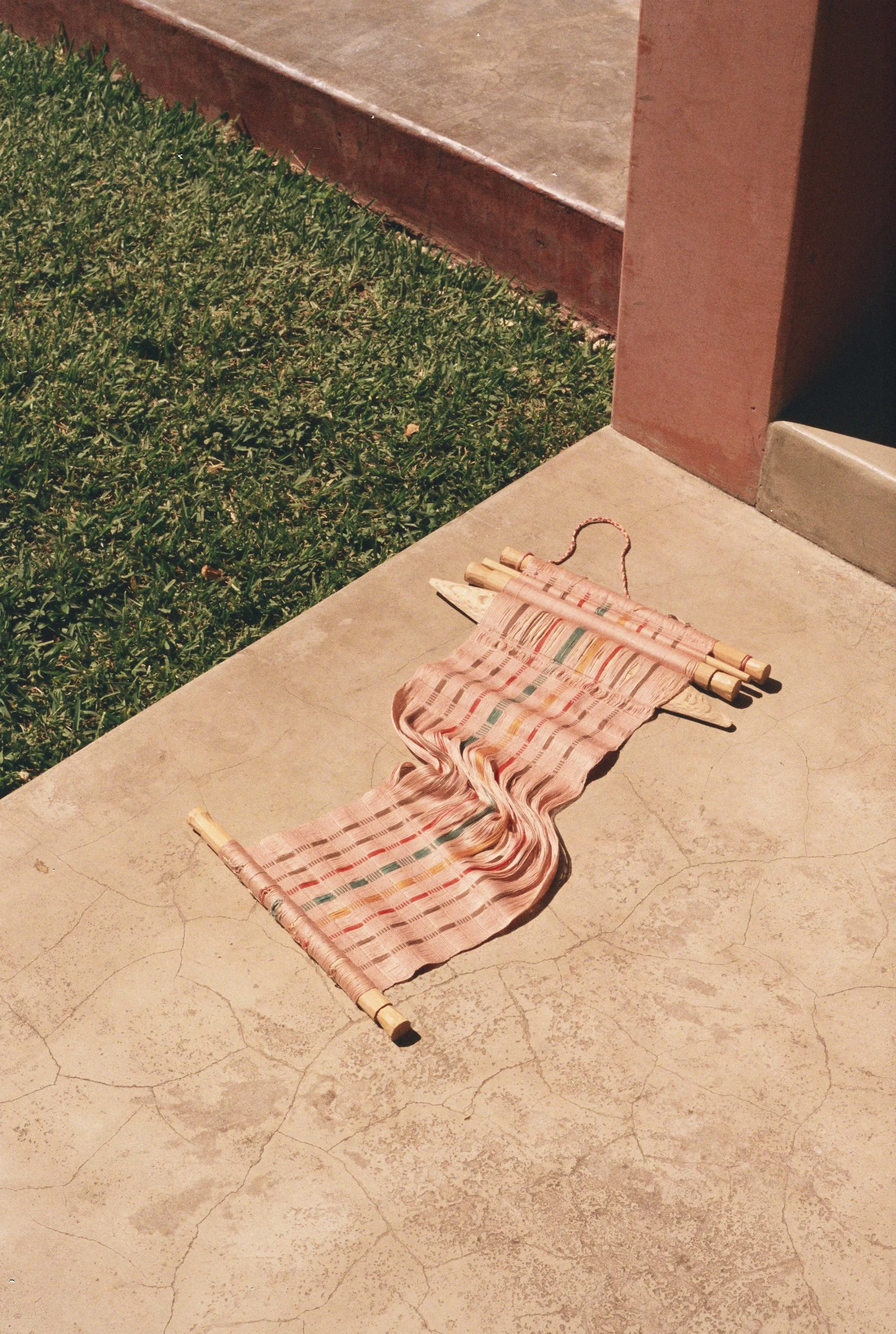A Glossary for Traditional Textiles from Guatemala
This glossary was written by our close friend and collaborator Averie Floyd of Casa Flor Designs, in Guatemala. Averie has over 10 years of experience working with weavers and artisans across Guatemala. Her project Casa Flor works to connect artisans with designers, to bring designs to life with the support of her team’s textile expertise and cross-cultural understanding. As cultural mediators, they help artisans and designers understand each other, show mutual respect and work together with clarity.
This glossary is a wonderful resource to better understand the complexities of Guatemalan textiles: the tools and processes required to make them, the parts that comprise them, and how to speak about them appropriately and with respect. We hope it is a useful tool for you!
A woman in Solola wears a faja skirt, huipil blouse, cinta belt and carries a tzute. Photograph by Celine Gaiardo.
Traditional Textiles
HUIPIL: (Pronounced “wee-peel”) A traditional blouse that is made by weaving 2-3 panels on the backstrap loom. Each panel is then joined together to make a top. One Huipil can require 1-6 months to make depending on the technique!
CORTE: (Pronounced “KOHR-teh”) A traditional skirt woven on a floor loom now a days. A length of fabric is folded around the waist and secured with a belt.
FAJA: (Pronounced “fa”hah”) The handwoven belt used to secure a corte to the waist.
RANDA: An embroidered joinery stitch used to join two pieces of cloth in a decorative way.
TZUTE: (Pronounced “soo-tay”) A piece of cloth used as a decorative accessory or used to carry things.
CINTA: (Pronounced “seen-tah”) A narrow woven piece of cloth worn as a hair piece in San Antonio Palopó (different regions have different names for decorative pieces worn on the head).
Dominga from Chuacruz, spins heirloom ixcaco cotton while wearing a traditional corte skirt and huipil blouse. Both textiles have elements of jaspe weaving, while the corte is connected with a randa seam, and the huipil has brocade woven designs.
Techniques
WOVEN: Fabric created using threads that cross interlace in vertical and horizontal directions
WARP: Threads set up in the vertical direction on the loom to create a woven fabric. The warp threads are set up as the first step to weaving and act as a base.
WEFT: Threads that go in the horizontal direction on the loom. This thread is added during the weaving process above and below each warp thread.
EMBROIDERY: Thread is added to a fabric using a needle.
BROCADE: Additional warp threads are placed at interval points during the weaving process to add color or create images.
JASPE: (Pronounced “HAHS pay”) Similar to Ikat, where a tie-dye technique is applied to threads before weaving.
TAPESTRY: A weft facing weaving technique where images are created via discontinuous weft threads. Usually these textiles are thicker.
CROCHET: A series of loops connected together row by row by using a hook to pull one loop of yarn through another loop.
A weaver counts threads while weaving on a backstrap loom. The solid colored threads are the warp, and the design is shown in the weft. Photo by Celine Gaiardo.
Weaving Process
THREAD WINDER: The Thread Winder is the first step in the weaving process and helps the weaver to convert a skein of thread into cones or balls of thread.
WARPING STAND: The second step in floor loom weaving is to organize the warp threads on a warping stand. This is where the weaver can start to lay out stripes in the warp.
WARP MILL or WARP BOARD: A crucial step to building the foundation for any handwoven fabric. This is the stage where stripes are created and the warp threads are organized so that they will not tangle when the loom is set up. There is a LOT of math that goes into this process. We leave that to the experts...
LOOM PREPARATION: The threads are hand placed through different loops attached to bars that will be lifted during the weaving process. This is a very time intensive process where the design of a fabric starts to take shape.
WEAVING: This is where the magic happens! Where the weavers add their own vision and personality. Where texture, color, and patterns come to life.
A backstrap loom rests on the ground with its woven textile.
Words to be Careful With
ARTISAN: Don’t say “Our Artisans” unless they are on your full time employee payroll. Some artisans prefer to be called artists! Just ask how they prefer to identify, give them a voice.
DESIGNER: You might be the designer of your brand, but unless you are a weaver of the Maya culture, you are not the designer of traditionally woven designs from Guatemala. Be sure to give credit to the communities or weavers where the design originates.
INSPIRED: “Traditional-inspired” without true collaboration risks cultural appropriation. Be transparent.
UPCYCLED HUIPIL: A greenwashing term often used to romanticize the resale or reuse of traditional garments. In reality, huipiles are rarely, if ever, discarded. When they appear in secondhand markets, it can sometimes be because a weaver has been forced—by poverty or lack of economic opportunity—to sell a piece of clothing deeply tied to her identity, community, and ancestral knowledge. Referring to these as “upcycled” erases the difficult choices and systemic inequities behind their resale. Be mindful of how this term is used and who profits from it.
SUSTAINABLE: Just choose a more specific word and educate people on everything that goes behind your product.
ETHICAL: Also a tricky one, this is nuanced. Try to be more specific with something you can back up. We like to say “responsibly sourced”. For us, responsibility means: transparency, thorough research, and honesty when we can do better.
Women wear their traje tipica (traditional clothing) at a textile market. Photo by Celine Gaiardo.
We hope this glossary is a useful tool in better understanding Guatemalan textiles and how to talk about them. Thank you Averie + the Casa Flor team!





